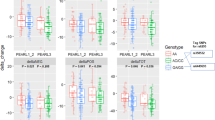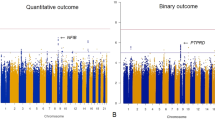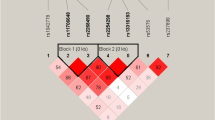ABSTRACT
Risperidone is a widely used atypical antipsychotic with certain advantages over typical antipsychotics. Although variations in the efficacy of treatment with risperidone have been observed, no specific predictable marker has been identified as of yet. In all, 73 Japanese patients with schizophrenia were given risperidone for 8 weeks, and clinical symptoms were evaluated using the Positive and Negative Syndrome Scale (PANSS). Six candidate polymorphisms (HTR2A −1438G>A, 102T>C, H452Y; DRD2 −141delC, Taq I A; COMT V158M) were genotyped. The diplotype configuration for each individual was estimated by the maximum-likelihood method. Multiple linear regressions were used to analyze the effects of these haplotypes/genotype and other prognostic factors on PANSS scale performance. After adjustment for the effects of patient-related variables, HTR2A diplotype and COMT genotype, as well as other potential prognostic factors, did not significantly influence the clinical performance. A DRD2 haplotype tended to correlate with better clinical performance. Compared with patients who had Ins-A2/Ins-A2 diplotype (n=25), PANSS total scores of patients with Ins-A2/Del-A1 diplotype (n=10) showed 40% greater improvement (P=0.03). The PANSS total scores of patients with HTR2A A-T/A-T diplotype (n=22) tended to show 15% worse improvement compared with A-T/G-C diplotype (n=33) (P=0.06). These results should be treated with caution because of limitations due to small sample size, heterogeneity of patients with respect to past antipsychotic use history, and no correction for multiple corrections. However, the present findings generate important hypotheses in a sample of Japanese schizophrenia patients that may lay the foundation for future pharmacogenomics investigations in other populations.
This is a preview of subscription content, access via your institution
Access options
Subscribe to this journal
Receive 6 print issues and online access
$259.00 per year
only $43.17 per issue
Buy this article
- Purchase on Springer Link
- Instant access to full article PDF
Prices may be subject to local taxes which are calculated during checkout
Similar content being viewed by others
References
Marder SR, Davis JM, Chouinard G . The effects of risperidone on the five dimensions of schizophrenia derived by factor analysis: combined results of the North American trials. J Clin Psychiatry 1997; 58: 538–546.
Meltzer HY . The role of serotonin in antipsychotic drug action. Neuropsychopharmacology 1999; 21: 106S–115S.
Stober G, Jatzke S, Heils A, Jungkunz G, Knapp M, Mossner R et al. Insertion/deletion variant (−141C Ins/Del) in the 5′ regulatory region of the dopamine D2 receptor gene: lack of association with schizophrenia and bipolar affective disorder. Short communication. J Neural Transm 1998; 105: 101–109.
Grandy DK, Zhang Y, Civelli O . PCR detection of the TaqA RFLP at the DRD2 locus. Hum Mol Genet 1993; 2: 2197.
Suzuki A, Kondo T, Mihara K, Furukori H, Nagashima U, Ono S et al. Association between Taq1 a dopamine D2 receptor polymorphism and psychopathology of schizophrenia in Japanese patients. Prog Neuropsychopharmacol Biol Psychiatry 2000; 24: 1105–1113.
Suzuki A, Kondo T, Mihara K, Yasui-Furukori N, Ishida M, Furukori H et al. The −141C Ins/Del polymorphism in the dopamine D2 receptor gene promoter region is associated with anxiolytic and antidepressive effects during treatment with dopamine antagonists in schizophrenic patients. Pharmacogenetics 2001; 11: 545–550.
Inayama Y, Yoneda H, Sakai T, Ishida T, Nonomura Y, Kono Y et al. Positive association between a DNA sequence variant in the serotonin 2A receptor gene and schizophrenia. Am J Med Genet 1996; 67: 103–105.
Arranz M, Collier D, Sodhi M, Ball D, Roberts G, Price J et al. Association between clozapine response and allelic variation in 5-HT2A receptor gene. Lancet 1995; 346: 281–282.
Ozaki N, Manji H, Lubierman V, Lu SJ, Lappalainen J, Rosenthal NE et al. A naturally occurring amino acid substitution of the human serotonin 5-HT2A receptor influences amplitude and timing of intracellular calcium mobilization. J Neurochem 1997; 68: 2186–2193.
Masellis M, Basile VS, Ozdemir V, Meltzer HY, Macciardi FM, Kennedy JL . Pharmacogenetics of antipsychotic treatment: lessons learned from clozapine. Biol Psychiatry 2000; 47: 252–266.
Lane HY, Chang YC, Chiu CC, Chen ML, Hsieh MH, Chang WH . Association of risperidone treatment response with a polymorphism in the 5-HT(2A) receptor gene. Am J Psychiatry 2002; 159: 1593–1595.
Egan MF, Goldberg TE, Kolachana BS, Callicot JH, Mazzanti CM, Straub RE et al. Effect of COMT Val108/158 Met genotype on frontal lobe function and risk for schizophrenia. Proc Natl Acad Sci USA 2001; 98: 6917–6922.
Shifman S, Bronstein M, Sternfeld M, Pisante-Shalom A, Lev-Lehman E, Weizman A et al. A highly significant association between a COMT haplotype and schizophrenia. Am J Hum Genet 2002; 71: 1296–1302.
Carlsson A, Waters N, Waters S, Carlsson ML . Network interactions in schizophrenia – therapeutic implications. Brain Res Brain Res Rev 2000; 31: 342–349.
Niu T, Qin ZS, Xu X, Liu JS . Bayesian haplotype inference for multiple linked single-nucleotide polymorphisms. Am J Hum Genet 2002; 70: 157–169.
Stephens M, Smith NJ, Donnelly P . A new statistical method for haplotype reconstruction from population data. Am J Hum Genet 2001; 68: 978–989.
Spurlock G, Heils A, Holmans P, Williams J, D'Souza UM, Cardno A et al. A family based association study of T102C polymorphism in 5HT2A and schizophrenia plus identification of new polymorphisms in the promoter. Mol Psychiatry 1998; 3: 42–49.
Segman RH, Heresco-Levy U, Finkel B, Goltser T, Shalem R, Schlafman M et al. Association between the serotonin 2A receptor gene and tardive dyskinesia in chronic schizophrenia. Mol Psychiatry 2001; 6: 225–229.
Veenstra-VanderWeele J, Kim SJ, Lord C, Courchesne R, Akshoomoff N, Leventhal BL et al. Transmission disequilibrium studies of the serotonin 5-HT2A receptor gene (HTR2A) in autism. Am J Med Genet 2002; 114: 277–283.
Jonsson EG, Nothen MM, Grunhage F, Farde L, Nakashima Y, Propping P et al. Polymorphisms in the dopamine D2 receptor gene and their relationships to striatal dopamine receptor density of healthy volunteers. Mol Psychiatry 1999; 4: 290–296.
Pohjalainen T, Nagren K, Syvalahti EK, Hietala J . The dopamine D2 receptor 5′-flanking variant, −141C Ins/Del, is not associated with reduced dopamine D2 receptor density in vivo. Pharmacogenetics 1999; 9: 505–509.
Thompson J, Thomas N, Singleton A, Piggot M, Lloyd S, Perry EK et al. D2 dopamine receptor gene (DRD2) Taq1 A polymorphism: reduced dopamine D2 receptor binding in the human striatum associated with the A1 allele. Pharmacogenetics 1997; 7: 479–484.
Noble EP, Blum K, Ritchie T, Montgomery A, Sheridan PJ . Allelic association of the D2 dopamine receptor gene with receptor-binding characteristics in alcoholism. Arch Gen Psychiatry 1991; 48: 648–654.
Noble EP, Gottschalk LA, Fallon JH, Ritchie TL, Wu JC . D2 dopamine receptor polymorphism and brain regional glucose metabolism. Am J Med Genet 1997; 74: 162–166.
Pohjalainen T, Rinne JO, Nagren K, Lehikoinen P, Anttila K, Syvalahti EK et al. The A1 allele of the human D2 dopamine receptor gene predicts low D2 receptor availability in healthy volunteers. Mol Psychiatry 1998; 3: 256–260.
Laruelle M, Gelernter J, Innis RB . D2 receptors binding potential is not affected by Taq1 polymorphism at the D2 receptor gene. Mol Psychiatry 1998; 3: 261–265.
Zalsman G, Frisch A, Lev-Ran S, Martin A, Michaelovsky E, Bensason D et al. DRD4 exon III polymorphism and response to risperidone in Israeli adolescents with schizophrenia: a pilot pharmacogenetic study. Eur Neuropsychopharmacol 2003; 13: 183–185.
Kay SR, Opler LA, Spitzer RL, Williams JB, Fiszbein A, Gorelick A . SCID-PANSS: two-tier diagnostic system for psychotic disorders. Compr Psychiatry 1991; 32: 355–361.
Ozaki N, Rosenthal NE, Pesonen U, Lappalainen J, Feldman-Naim S, Schwartz PJ et al. Two naturally occurring amino acid substitutions of the 5-HT2A receptor: similar prevalence in patients with seasonal affective disorder and controls. Biol Psychiatry 1996; 40: 1267–1272.
Lachman HM, Papolos DF, Saito T, Yu YM, Szumlanski CL, Weinshilboum RM . Human catechol-O-methyltransferase pharmacogenetics: description of a functional polymorphism and its potential application to neuropsychiatric disorders. Pharmacogenetics 1996; 6: 243–250.
Weir BS Genetic Data Analysis II. Sinauer Associates: Sunderland, MA, 1996.
Acknowledgements
We gratefully acknowledge helpful discussions with Drs Y Ono and S Hashimoto on several points in the paper. We thank Ms Y Zusho and Ms M Miyata for their technical support. This work was supported in part by research grants from the Japanese Ministry of Education, Culture, Sports, Science and Technology and the Japanese Ministry of Health, Labor and Welfare.
Author information
Authors and Affiliations
Corresponding author
Additional information
DUALITY OF INTEREST
None declared.
Rights and permissions
About this article
Cite this article
Yamanouchi, Y., Iwata, N., Suzuki, T. et al. Effect of DRD2, 5-HT2A, and COMT genes on antipsychotic response to risperidone. Pharmacogenomics J 3, 356–361 (2003). https://doi.org/10.1038/sj.tpj.6500211
Received:
Revised:
Accepted:
Published:
Issue Date:
DOI: https://doi.org/10.1038/sj.tpj.6500211
Keywords
This article is cited by
-
Ethnic Differences in Antipsychotic Response: What Genetic Variation Does and Does Not Tell Us
Current Behavioral Neuroscience Reports (2023)
-
Variants of GRM7 as risk factor and response to antipsychotic therapy in schizophrenia
Translational Psychiatry (2020)
-
Association studies of genomic variants with treatment response to risperidone, clozapine, quetiapine and chlorpromazine in the Chinese Han population
The Pharmacogenomics Journal (2016)
-
Influence of ANKK1 and DRD2 polymorphisms in response to haloperidol
European Archives of Psychiatry and Clinical Neuroscience (2013)
-
Candidate-gene association analysis of response to risperidone in African-American and white patients with schizophrenia
The Pharmacogenomics Journal (2009)



